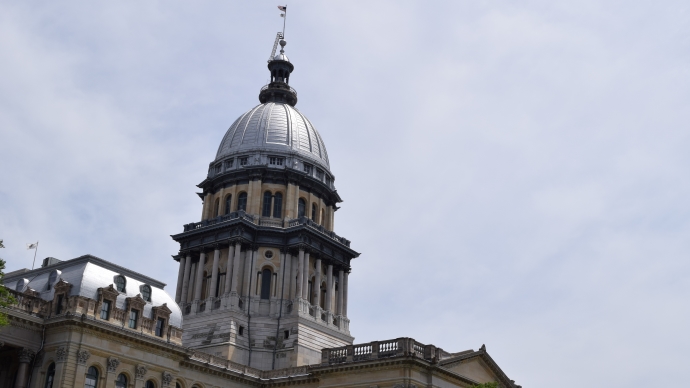High property taxes drive school funding inequity. But for every 2 districts that over-tax, there is at least 1 under-taxing district out there.
The Evidence-Based Funding Formula identifies a target property tax rate for every district. The model calculates how much each district needs to be funded adequately. It then specifies a local capacity percentage (LCP) based on how much property wealth each district has. A district with lots of property wealth will have an LCP of up to 90%. That means if a district’s per pupil adequacy target is $12,000 and its LCP is 75%, the formula expects the district to raise $9,000 per pupil locally. From there, we can back into an “implied” tax rate for each district.
Most districts tax themselves higher than their implied tax rate. (Those are all the orange dots above the blue line in the chart below.) But 310 districts (the orange dots below the blue line) actually tax themselves lower than that rate. A rate freeze would impact these districts across the board. Freezing undertaxed districts would guarantee that those schools will never reach adequate funding. (And inflationary increases compound quickly, so lots of the 543 districts that are “over-taxing” now would fall under the blue line after a few years of increased adequacy costs and frozen levies.)

Addressing property taxes in the formula was a sticking point during the school funding negotiations. Should the formula recognize districts’ whole property tax levy? If they are over-taxing themselves, that could push the districts into a higher tier and further solidify their reliance on property taxes. If they are under-taxing themselves, that could knock them down a tier and put them in line for more state funding than other deserving districts that have put forth more local effort.
On the other hand, should the formula ignore actual rates and just use the implied rates? That would completely disconnect the question of how districts tax locally with how much state funding they get for their schools. There would be no incentive to under-tax, but no disincentive to over-tax.
The Evidence-Based Formula decided to use the best of both worlds: for districts that were under-taxing (the orange dots below the blue line), the model assumes they are taxing at their implied rate (the blue line itself). For districts that are over-taxing themselves (orange dots above the blue line), the model recognizes a portion of their overage in order to encourage them to reduce their rates. How much depends on how much property wealth a district has. The overage is multiplied by the district’s LCP, thus wealthier districts will be penalized more for overtaxing and therefore, incentivized further to lower their levies.
Let’s look at a few examples:
- An under-funded district trying to compensate locally. North Chicago SD 187, a property-poor district that is expected to raise just 10% of its funds locally. That gives the district a $5.5 million target levy. However, North Chicago is so underfunded, it taxes itself almost twice that much, $5.1 million more. Because the district’s LCP is 10%, just 10% of that over-levy will “count” against the district in the formula.
- An above-adequacy over-taxer. The property-wealthy Bannockburn SD 106 is expected to raise $1.8 million, which is 90% of its adequacy target. But the district brings in $5.5 million, $4.7 million more than the model expects. The formula will recognize 90% of Bannockburn’s $4.7 million overage.
- An almost-adequate under-taxer. Rockdale SD 84 in Will County is expected to raise 60% of its adequacy target from property taxes. But it only brings in 24% of that total. Its implied tax rate is 3.2%, but its actual rate is just about 1.2%. The formula assumes that Rockdale raises its full Local Capacity Target. It would hardly be fair to the rest of the districts to reward Rockdale’s under-taxing with more state money. But it would be equally unfair to Rockdale to freeze its levy where it is, so far from its expected rate with a formula that assumes it has access to those resources.
In the statewide aggregate, there are over $3 billion in property taxes levied by school districts above what the formula expects them to bring in. About $2 billion of those are for school districts funded below adequacy. There are about $1 billion in property tax over-levies in over-adequacy districts. Finally, there are $670 million in uncaptured property tax receipts, almost all in districts that are funded below adequacy.

Finding the right balance between providing property tax relief and moving toward adequate school funding is a challenge. If it was easy, someone would have done it. But it’s worth it to wade into this complex territory because this is such a critical issue. Let’s just make sure we acknowledge that it is complicated and will require more than a one-size-fits-all solution.





